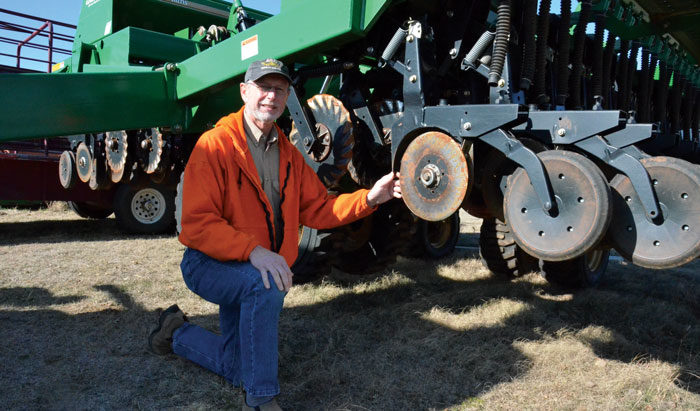No-Till Farmer
Get full access NOW to the most comprehensive, powerful and easy-to-use online resource for no-tillage practices. Just one good idea will pay for your subscription hundreds of times over.

RESIDUE MANAGEMENT. Oklahoma no-tiller Mark Nault says his Great Plains no-till drill equipped with coulters to handle increased residue enables him to develop a rotation based around spring and fall covers, winter wheat and grain sorghum. Photo Dan Crummett
Mark Nault of Okeene, Okla., is a relatively new no-tiller and admits the learning curve has been steep over the past several years.
Still, he says the improvements he’s seen in soil organic matter in his shallow topsoil fields, along with much improved water-infiltration rates, have convinced him he’s on the right track. A third-party economic study showing positive returns to his management changes also gives him encouragement.
Nault, a third-generation grower, farms 450 acres in northwestern Oklahoma’s Blaine County. There, doing business as 2N2E Farms, he hopes to develop a cover crop, wheat and grain sorghum rotation when Oklahoma’s increasingly erratic rains cooperate. In addition to his own acres, Nault also farms other land with his brother, Raymond, who is also experimenting with no-till.
The farms consist mostly of Kingfisher silt loam on a flat upland shelf that slopes quickly to rough, red gumbo soils toward the distant Cimarron River drainage.
“The most productive soils are on top of the shelf, and as the farm slopes, the soils are more eroded from years of conventional tillage wheat/fallow management, and I have to farm around some terraces that are as close as 60 feet in some fields,” he says.
Nault’s Farm, like most others in the Middle Cimarron drainage 50 miles west of I-35, had been in continuous winter wheat production for decades. That meant every year wheat stubble was plowed under in late June, and one or more…